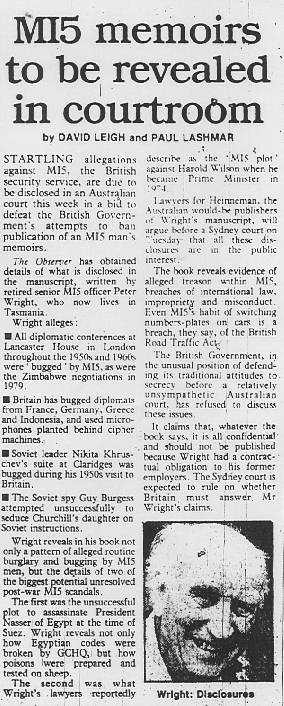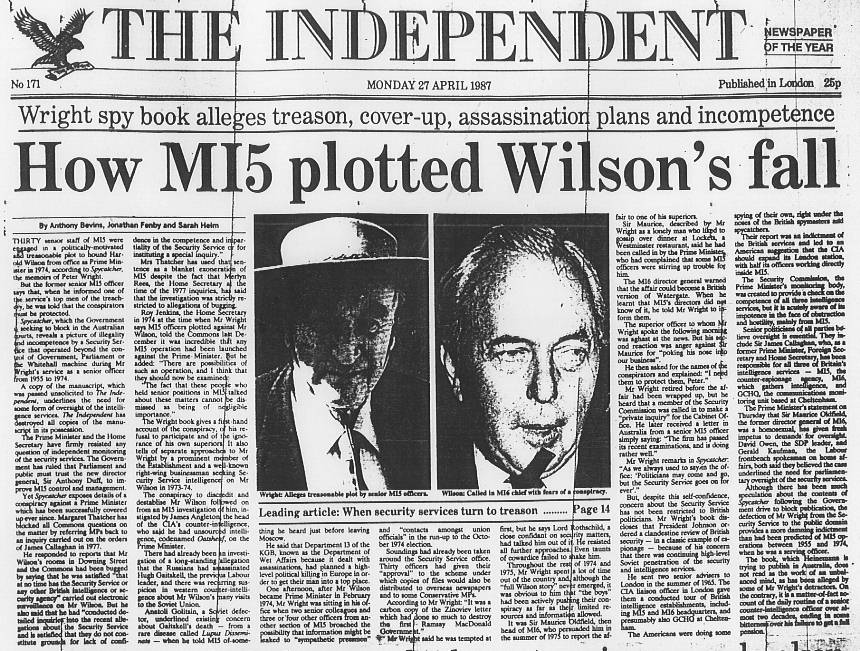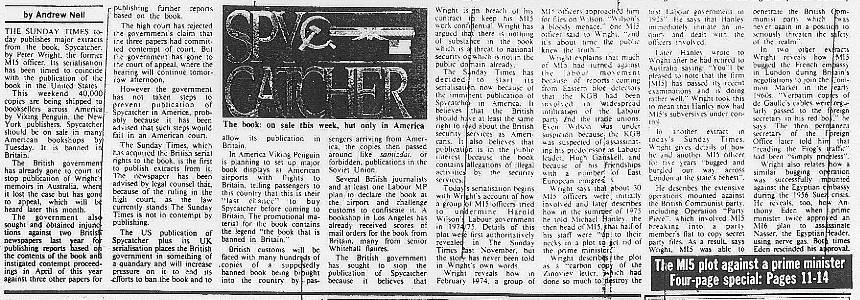Book Review of Peter Wright's "Spycatcher"
Spycatcher: The Candid Autobiography of a Senior Intelligence Officer by Peter Wright, former assistant director of MI5, published in 1987.Peter Wright joined MI5's A2 branch in 1955 as Principal Scientist; he served until 1976. Before joining he underwent two days training by John Cuckney, whom he quotes as saying of MI5's legal status, "It hasn't got one. The Security Service cannot have the normal status of a Whitehall department because its work very often involves transgressing propriety or the law." Cuckney went on to make clear that MI5 operated on the basis of the 11th commandment - "thou shalt not get caught".
In 1951, Burgess and Maclean defected; in 1955 MI6 sacked Philby, who in 1963 defected from Beirut. Much of Wright's career is in pursuing moles in MI5/MI6, in particular he is taken with the theory that Roger Hollis, former Director-General of MI5, was a Russian mole. He writes of his early years in counter-espionage, "For five years we bugged and burgled our way across London at the State's behest, while pompous bowler-hatted civil servants in Whitehall pretended to look the other way." Wright says, "the most extensive microphoning operation [we] ever undertook was in Lancaster House ... which hosted the Colonial conferences of the 1950s and 1960s." He says a "comprehensive microphoning system throughout the building" was installed and used "throughout the rest of the 1960s and 1970s, whenever high-level diplomatic negotiations took place in London."
Wright specialised in "bugging" interception activities of various shapes and forms. Some of these activities were rapidly discovered and countered by the Soviets and their allies, which led him to the belief that a mole within MI5 was at work.
One of Peter Wright's successes was in listening to (i.e. bugging) the actions of a mechanical cipher machine, in order to break their encryption. This operation was code-named ENGULF, and enabled MI5 to read the cipher of the Egyptian embassy in London at the time of the Suez crisis. Another cipher-reading operation, code-named STOCKADE, read the French embassy cipher by using the electro-magnetic echoes of the input teleprinter which appeared on the output of the cipher machine. Unfortunately, Wright says this operation "was a graphic illustration of the limitations of intelligence" - Britain was blocked by the French from joining the Common Market and no amount of bugging could change that outcome.
Particularly interesting is MI5's invention code-named RAFTER, which is used to detect the frequency a radio receiver is tuned to, by tracing emissions from the receiver's local oscillator circuit. RAFTER was used against the Soviet embassy and consulate in London to detect whether they were listening in to A4-watcher radios. Wright also used this technique to try to track down Soviet "illegals" (covert agents) in London who received their instructions by radio from the USSR.
Central to "Spycatcher" is Wright's theory that there was a mole at the heart of MI5 for many years, and that the mole was the Director-General himself, Roger Hollis. This theory was based partly on the reports of British/US agents in Soviet-bloc countries, and the reports of Soviet defectors; and partly on the rapid discoveries by the Soviets of actions against them by MI5. The possibilities were narrowed down to Roger Hollis and his deputy-DG, Graham Mitchell. The investigation of Mitchell arrived at no result, and was followed by an internal investigation of Hollis which also gave no results.
In 1959 the CIA asked Wright about assassination methods; "we're developing a new capability in the Company to handle these kind of problems, and we're in the market for the requisite expertise."; to which he replied that "we'd certainly have that capability but I doubt we would use it nowadays." MI6 had intended during the Suez crisis to assassinate Nasser using nerve gas, but their plot had been foiled. Wright said the SAS "don't freelance", adding, "the French! have you tried them? It's more their type of thing, you know. Algiers, and so on." He describes how MI6 developed poisons which were tried on a sheep at Porton Down; it started "rolling its eyes and frothing at the mouth", and promptly died.
The core of the book is in Wright's 1960s search for a mole, who would have been recruited by the Russians thirty years earlier. The book examines the various people and their inter-relationships from the 1930s, which have relevance to the search for a mole in the 1960s. There is much reference in the book to the student days of people like Blunt and their lives as homosexuals, their membership of secret societies such as the Apostles, etc. One anecdote which was reported in the papers concerns the allegation that Burgess's Soviet controllers ordered him to wed Churchill's daughter Clarissa, as a cover for his espionage activities - he was unsuccessful in this task.
Perhaps the book's weakest point from my subjective point of view is that the material covered is all so old. It covers Wright's work in the 1960s to investigate relationships which were forged in the 1930s. Wright left the Security Service over twenty years ago and the book is simply ancient history.
Anyway, back to the review! The FLUENCY project at MI5 researched the history of penetration of British Intelligence, particularly from accounts of UK/US "assets" in Soviet countries, and Soviet-bloc defectors to the West. These accounts, taken together, hinted in the direction of Hollis. But no conclusive, clinching proof was ever found. And Hollis, soon before stepping down as DG, said to Wright; "Well, Peter, you have got the manacles on me, haven't you? All I can say is that I am not a spy."
Towards the end of "Spycatcher" Wright starts to talk of items beyond the concerns of 1960s mole-hunting. He talks about a "decisive shift inside MI5 towards domestic concerns", and includes a few words on MI5's operations in Northern Ireland. He mentions "student militancy in the 1960s gave way to industrial militancy in the 1970s", adding that "intelligence on domestic subversion became the overriding priority". He also comments of the increasing computerisation of MI5 and their projected links to state computer databases such as the National-Insurance database at Newcastle; "from now on we were to be data processors."
In the book's final chapter, Wright talks of approaches from colleagues who said of the prime minister, "Wilson's a bloody menace and it's about time the public knew the truth .... this time we'll have him out." Wright goes on to say, "Although the full Wilson story never emerged, it was obvious to me that the boys had been actively pushing their plan as much as they could. No wonder Wilson was later to claim that he was the victim of a plot!"
Peter Wright concludes the book with a mention of the Trend inquiry in 1974 into the question of whether Hollis was indeed a Russian mole. In 1981 prime minister Thatcher told the Commons that Trend had concluded Hollis was not a Russian agent. On this note ends the 382-page saga of mole-hunting.
MI5 Booklet Replies to "Spycatcher" Allegations
The third edition of HMSO official publication "MI5 The Security Service" has the following to say on the "Wilson Plot" allegations;"In his book Spycatcher, the former Security Service officer Peter Wright claimed that up to 30 members of the Service had plotted to undermine the former Prime Minister Harold Wilson. This allegation was exhaustively investigated and it was concluded, as stated publicly by Ministers, that no such plot had ever existed. Wright himself finally admitted in an interview with BBC1's Panorama programme in 1988 that his account had been unreliable."
It adds the following about Wright's claim that Hollis was a Russian mole;
"It was claimed that the former Director General of the Security Service, Sir Roger Hollis, was a Russian spy. The Trend inquiry of 1974 cleared Hollis of that accusation. Subsequently, the evidence of the former KGB officer Oleg Gordievsky confirmed this judgment."
The booklet in general is pretty much a whitewash of MI5's activities, so nobody need be surprised by the statements quoted above.
Brief Outline of the "Spycatcher" Affair
 In September 1985 the Attorney General began proceedings in New South
Wales to prevent Peter Wright and his publisher from publishing his book
Spycatcher which contained an account of alleged irregularities and
illegalities by members of the security service. On June 22 and 23, 1986,
the Observer and Guardian newspapers respectively published articles
giving the outline of Wright's allegations. The Observer article is
reproduced to the left of this paragraph. On 27 June 1986 the Attorney
General obtained "gagging order" ex-parte injunctions these two
newspapers, followed by an inter partes hearing on July 11 which
continued the injunctions.
In September 1985 the Attorney General began proceedings in New South
Wales to prevent Peter Wright and his publisher from publishing his book
Spycatcher which contained an account of alleged irregularities and
illegalities by members of the security service. On June 22 and 23, 1986,
the Observer and Guardian newspapers respectively published articles
giving the outline of Wright's allegations. The Observer article is
reproduced to the left of this paragraph. On 27 June 1986 the Attorney
General obtained "gagging order" ex-parte injunctions these two
newspapers, followed by an inter partes hearing on July 11 which
continued the injunctions.
Then on March 13, 1987 the British Government's action in New South Wales was dismissed by the Australian judge.

